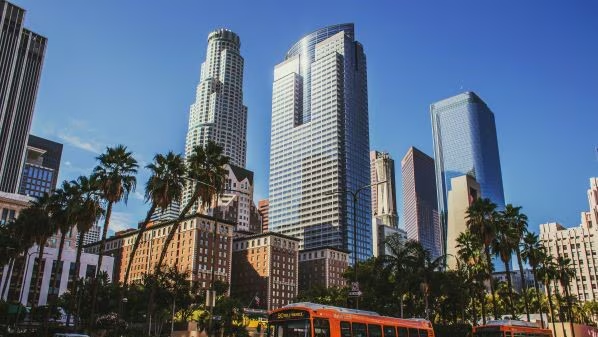From the pulsating entertainment industry to the vast cityscape, Los Angeles has turned into a playground for architectural experiments. The skyline of this city, once dominated by low-rise structures, is currently adorned with a number of proud tall buildings that demonstrate its evolution into a global metropolis. The paper reviews some of the tallest structures in Los Angeles based on their architectural importance, feats of engineering, and influence on the urban landscape.
The Evolution of L.A.’s Skyline
Los Angeles’s transformation from a low-rise town to a vertical metropolis reflects some broader trends of urban development. The growing needs for high-density living and working spaces, as well as engineering and architectural advances that facilitate the building of towering skyscrapers, have helped shape the city’s skyline. Such tall buildings are not merely about redefining the architectural face of LA; they stand to symbolize its economic growth and modernizing ambitions.
- Wilshire Grand Center
Height: 1,100 ft; 335 m
Completed: 2017
Architecture Firm: AC Martin
The Wilshire Grand Center dominates the Los Angeles skyline as the tallest building in the city and is widely regarded as a shining example of contemporary architectural success. Completed in 2017, this skyscraper soars high into the sky at 1,100 feet, towering above all its predecessors with sheer originality in design and engineering feats.
The building’s design uses the sail form as a means for AC Martin to refer to and celebrate Los Angeles’ history of its relationship with the sea. Its glass façade is sleek, and the spire lights up dynamically with LED lights, glowing brightly within the view of the skyline. Inside, the Wilshire Grand Center contains a luxury hotel, office spaces, retail outlets, and restaurants. The building acts as a central hub in Downtown L.A. With its base isolation technology, it is constructed to be safe in terms of earthquake safety and becomes symbolic of L.A.’s commitment to safety in the design of tall buildings.
- U.S. Bank Tower
Height: 1,018 feet; 310 meters
Completed: 1989
Architect: Henry N. Cobb (Pei Cobb Freed & Partners)
Before the Wilshire Grand Center, the U.S. Bank Tower held the title of the tallest building in Los Angeles. This 1,018-foot iconic skyscraper was completed in 1989 and represented a major upshot in vertical development for the city. Architect Henry N. Cobb, of Pei Cobb Freed & Partners, designed this cylindrical-shaped building with a crowning feature atop that has become quite recognizable in the skyline.
The building’s design includes a core with reinforced concrete and strong materials to enhance the stability and safety of the occupants, considering that the city is prone to seismic activity. The U.S. Bank Tower has been symbolic of corporate power and economic growth by renting out offices to many high-end tenants and contributing to the rebirth of Downtown Los Angeles.
- Salesforce Tower
Height: 861 feet (262 meters)
Completed: 2017
Architect: Kevin Roche John Dinkeloo and Associates LLC
Yet another towering architectural addition to the L.A. skyline, the Salesforce Tower was completed in 2017 and is 861 feet tall. Situated at the center of Downtown, this skyscraper resembles the city embracing modern architecture and technical advancement. The Salesforce Tower features a sleek modern design, with a glass curtain wall that uplifts its aesthetic appeal, created by Kevin Roche John Dinkeloo and Associates, LLC.
It serves as one of the primary working offices for Salesforce and other major tenants and aids in driving activity in the central business district. Its design values energy efficiency and sustainability as one of the hallmarks of recent times in green building. With the height and primate area the Salesforce Tower occupies, it adds to the skyline, symbolizing L.A.’s growth in influence in tech and business.
- 777 Tower
Height: 735 feet; 224 meters
Year completed: 1991
Architect: Kevin Roche John Dinkeloo and Associates LLC
The 777 Tower was completed in 1991, with a height of 735 feet; at the time, this building was among the highly visible developments on the Los Angeles skyline. Completed by the Kevin Roche John Dinkeloo and Associates, LLC, architectural firm, the tower features a smooth and sleek modern design that fits properly with the surroundings of Downtown L.A.
The 777 Tower houses offices and has become part of the city’s commercial landscape. Its height and design reflect the trends of the early 1990s when high-strength materials and modern architectural techniques were in use. Its inclusion in the skyline shows Los Angeles’ evolution into a major urban center with an increasing number of tall buildings.
-
Bank of America Tower
Height: 735 feet; 224 meters — Year: 2009 — Architect: Kevin Roche John Dinkeloo and Associates, LLC — The Bank of America Tower is another building that peaks at 735 feet (thus among the tallest in Los Angeles). Completed in 2009 by Kevin Roche John Dinkeloo and Associates, LLC, it is prominent for its slick, modern design and green building techniques.
Its glass curtain wall and strong spire give it a significant visual impact on the skyline. Its design reflects the prominence given to energy efficiency, and thus environmental sustainability, of present-day building. A central office building, the Bank of America Tower plays a central role in the business district and thus plays an important role in the economic growth and development of Downtown L.A.
The Impact of Tall Buildings on Los Angeles
Tallest buildings in Los Angeles are not only objects of architecture; they are the essence of growth and ambition taken by this city. The addition of skyscrapers to this urban fabric not only increases high-density office space, luxury accommodations, and retail opportunities but has also encouraged renovation in Downtown Los Angeles from a once-neglected area into a beehive commercial and cultural center.
These tall buildings economically attract businesses and investors to drive job creation and economic development. They also serve to raise the global profile of the city, showcasing Los Angeles as a modern and dynamic city with a very developing skyline.
Culturally, L.A.’s tallest buildings have been its significant landmarks and identity symbols. When viewed from several vantage points, some of the designs stand out, enabling them to be used as recognizable icons of the skyline and depicting in film, television, and advertising. The skyscrapers define the visual character of the city and its public image.
The future of L.A.’s Skyline
As the city of Los Angeles grows, so does the changing skyline. The trend is toward ever-taller buildings with unique, sleek designs, and this is something that will only continue as the city grows and the demand for more high-density development increases. The next generation of skyscrapers will be sustainable, drawing not only from green building practices but also from innovative technologies that help combat environmental problems.
The future of the Los Angeles skyline will be in terms of growth versus community needs. As the city reaches upward, continuing debates will spring up around affordable housing, transportation options, and the place that tall buildings hold within the urban setting. Ensuring that new developments help to enrich quality of life for residents and benefit communities will be important as Los Angeles looks forward into the future.
Conclusion
From the Wilshire Grand Center to the U.S. Bank Tower, Salesforce Tower, 777 Tower, and Bank of America Tower, these are the best examples of architectural and engineering work that Los Angeles has seen. These skyscrapers have dramatically changed the face of L.A. to represent expansion, determination, and taste. As Los Angeles grows even more, all these iconic buildings will be a part of its identity, showcasing its dynamic spirit and hopes for the future. The tallest buildings in L.A. talk of landmarks, business hubs, or cultural icons and show the changing face of the city toward a worldly metropolis.







